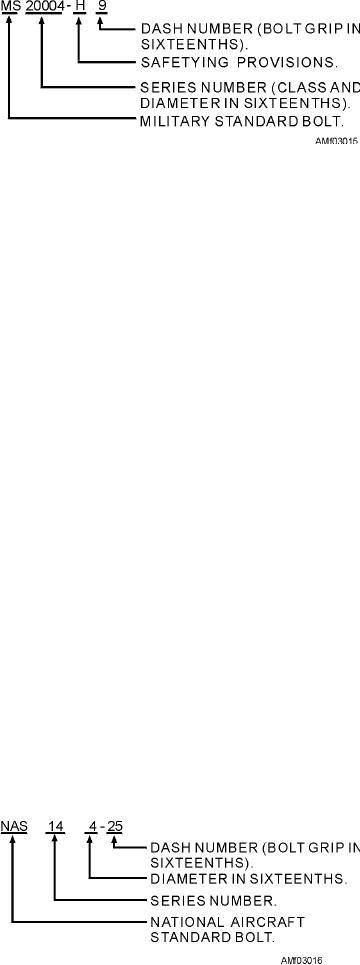
shows that this part number represents a
general-purpose hex-head bolt. However, the part
numbers for some bolts of this class have two digits. In
fact, general-purpose hex-head bolts include all part
numbers beginning with AN3, AN4, and so on, through
AN20. Other series numbers and the classes of bolts
they represent are as follows:
AN21 through AN36--clevis bolts
AN42 through AN49--eyebolts
Figure 3-15.--MS bolt part number breakdown.
The series number shows another type of
information other than bolt class. With a few
exceptions, it indicates bolt diameter in sixteenths of an
In considering the NAS144-25 bolt (special
inch. For instance, in figure 3-14, the last digit of the
internal-wrenching type), observe that the bolt
series number is 4; therefore, this bolt is 4/16 of an inch
identification code starts with the letters NAS. Next, the
(1/4 of an inch) in diameter. In the case of a series
series has a three-digit number, 144. The first two digits
number ending in 0, for instance AN30, the 0 stands for
(14) show the class of the bolt. The next number (4)
10, and the bolt has a diameter of 10/16 of an inch (5/8
indicates the bolt diameter in sixteenths of an inch. The
of an inch).
dash number (25) indicates bolt grip in sixteenths of an
inch.
Refer again to figure 3-14, and observe that a dash
follows the series number. When used in the part
Nuts
numbers for general-purpose AN bolts, clevis bolts,
and eyebolts, this dash indicates that the bolt is made of
Aircraft nuts differ in design and material, just as
carbon steel. With these types of bolts, the letter C, used
bolts do, because they are designed to do a specific job
in place of the dash, means corrosion-resistant steel.
with the bolt. For instance, some of the nuts are made of
The letter D means 2017 aluminum alloy. The letters
cadmium-plated carbon steel, stainless steel, brass, or
DD stand for 2024 aluminum alloy. For some bolts of
aluminum alloy. The type of metal used is not identified
this type, a letter H is used with these letters or with the
by markings on the nuts themselves. Instead, the
dash. If it is so used, the letter H shows that the bolt has
material must be recognized from the luster of the
been drilled for safetying.
metal.
Next, observe the number 20 that follows the dash.
Nuts also differ greatly in size and shape. In spite of
This is called the dash number. It represents the bolt's
these many and varied differences, they all fall under
grip (as taken from special tables). In this instance the
one of two general groups: self-locking and
number 20 stands for a bolt that is 2 1/32 inches long.
nonself-locking. Nuts are further divided into types
The last character in the AN number shown in
such as plain nuts, castle nuts, check nuts, plate nuts,
figure 3-14 is the letter A. This signifies that the bolt is
channel nuts, barrel nuts, internal-wrenching nuts,
not drilled for cotter pin safetying. If no letter were used
external-wrenching nuts, shear nuts, sheet spring nuts,
after the dash number, the bolt shank would be drilled
wing nuts, and Klincher locknuts.
for safetying.
MS Part Number.--MS is another series of bolts
used in aircraft construction. In the part number shown
in figure 3-15, the MS indicates that the bolt is a
Military Standard bolt. The series number (20004)
indicates the bolt class and diameter in sixteenths of an
inch (internal-wrenching, 1/4-inch diameter). The letter
H before the dash number indicates that the bolt has a
drilled head for safetying. The dash number (9)
indicates the bolt grip in sixteenths of an inch.
NAS Part Number.--Another series of bolts used
Figure 3-16.--NAS bolt part number breakdown.
in aircraft construction is the NAS. See figure 3-16.
3-9

